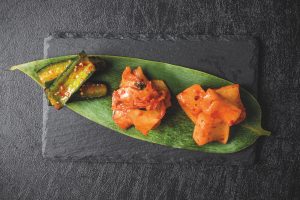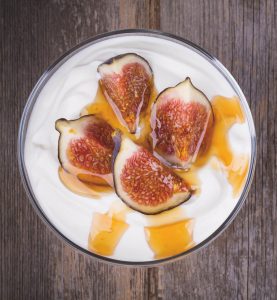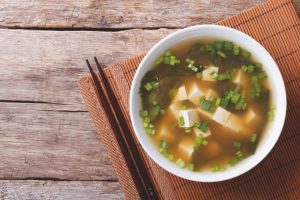Gut Health
Gut-friendly foods from around the world
Here at Liz Earle Wellbeing, we can’t get enough of gut-friendly foods. If you’re looking for some new inspiration to add alongside your daily dose of kefir and kombucha, take a look at some of our favourite fermented dishes from around the world.
Gut-friendly gems are found all over the world – from Greece to Korea and beyond. They’re often time-honoured foods that have fed and nourished local people with their goodness for generations.
Our favourite gut-friendly foods
 Kimchi
Kimchi
Kimchi is a traditional Korean dish that’s very popular in both North and South Korea. It’s eaten most mealtimes, so it’s no surprise Koreans each get through 25kg a year. Kimchi is often served simply with white rice, it’s also used in recipes for other national favourites, such as rich kimchi jjigae (stew).
This sweet-sour Korean staple is a spicy pickle fermented in brine (in the same way as German sauerkraut). It’s made with seasonal vegetables – often cabbage or sometimes radish, cucumber or onion – combined with fish sauce or dried shrimp, and seasonings such as chilli, garlic and ginger. Because it’s fermented, kimchi is probiotic and rich in good bacteria, which promotes good gut heath.
Many countries have a favourite traditional preserve with a history of sustaining families through the leaner seasons. But so important is kimchi to Korean culture that it appears on UNESCO’s Intangible Cultural Heritage of Humanity list. The process, known as kimjang, follows a yearly cycle: in spring, Koreans gather in shrimps, anchovies and other seafood for salting and fermenting; in summer, they buy sea salt for brine and procure red chilli peppers for drying and grinding; and autumn is kimjang season when the kimchi is made and shared by households, ensuring every family has enough to last the winter.
 Strained yoghurt
Strained yoghurt
This gut-friendly food is a famous Greek speciality that’s called straggisto in the native tongue. Like other yoghurts, it’s made from milk that’s heated then cooled to the correct temperature before bacterial cultures are added and left to ferment.
In Greece, this milk traditionally comes from locally reared sheep. Much if what we call Greek yoghurt here in the UK is made with cow’s milk. But whether from a sheep or cow, one thing we agree on is that true Greek yoghurt is strained to remove a high proportion of the watery whey. This is the liquid left after the milk is curdled.
This straining process makes Greek yoghurt pleasingly thick and unctuous. It’s perfect for a cooling homemade tzatziki, or served with a little local honeycomb as an indulgent breakfast. Because it’s strained, it’s also sometimes used in traditional Greek cooking, in soups for example. Its comparatively high fat content means it’s better able to withstand high temperatures without curdling.
In nutritional terms, strained yoghurt is higher in protein – it can contain twice the amount of regular yoghurt. Because it’s more concentrated, it has more gut-friendly probiotics, too.
And that’s not all. Straining removes some of the lactose, making it naturally lower in sugar. Middle Eastern labneh and Scandinavian skyr are also styles of strained yoghurt.
 Miso
Miso
Miso is a staple seasoning in its native Japan. It’s another fermented product that contains good bacteria. In Japanese, miso means ‘fermented beans’. This paste has an intense flavour. It’s made from soya beans (one of the central ingredients in Japanese cuisine) and sometimes cereal grains, such as rice or barley.
Miso contains a fermentation culture called koji (also used in other Japanese specialities, such as soy sauce and sake) that’s produced with a naturally occurring fungus called Aspergillus oryzae.
There are many different varieties of miso, including shinshu (light- yellow miso), aka (red miso) and shiro (sweet white miso). The longer the fermentation, the darker and deeper flavoured the miso. The different cereal grains used also influence the flavour.
This salty paste forms the basis of the classic Japanese soup of the same name. Here it’s combined with other local ingredients, including a fish stock called dashi, mirin (rice wine), tofu (also made with soya beans) and dried nori or wakame (seaweed). Miso soup is used as the starting point for a nourishing ramen, and the paste itself for meat, fish or vegetables as a marinade, sauce or dressing, too.
On the map
Paying a visit to France or Norway? Taste these other gut-friendly foods in their countries of origin.
- No trip to the French Alps would be complete without a gooey wedge of unpasterised soft cheese, or dollop of crème fraîche served alongside a warm slice of apple tart.
- Fans of tofu should try tempeh when in Indonesia – it’s made with fermented soya beans (unlike tofu, which isn’t usually fermented).
- Make a smørrebrød (an open sandwich on a slice of dark rye bread), your light lunch of choice in Scandinavia. Rye flour is higher in gut-friendly fibre than wheat flour.
- In Tibet, the Sho Dun (meaning ‘yoghurt feast’) Festival celebrates the country’s traditional sour yoghurt, which is made from creamy yak’s milk.
Love gut-friendly foods? Read on here:
Wellbeing Wisdom
- Kimchi is probiotic and rich in good bacteria, which promotes good gut heath
- Strained yoghurt is higher in protein – it can contain twice the amount of regular yoghurt – and because it’s more concentrated, it has more gut-friendly probiotics, too
- Miso is another fermented product that contains good bacteria

 Kimchi
Kimchi Strained yoghurt
Strained yoghurt Miso
Miso


